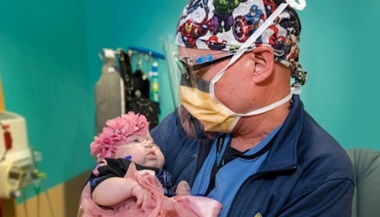Esophageal Atresia
What is esophageal atresia?
Esophageal atresia is a rare, congenital (present at birth) disorder of the digestive system in which the esophagus, the tube that normally carries food from the mouth to the stomach, does not connect with the lower esophagus and stomach. In most babies with this condition, the top end of the lower esophagus abnormally connects to the windpipe, a connection called a tracheoesophageal fistula (TEF). Some babies with esophageal atresia will also have other problems, such as heart conditions or other digestive tract disorders.
Types of Esophageal Atresia
- Type A: The upper and lower segments of the esophagus are not connected. Type A does not have a TEF. This is the second most common type of esophageal atresia.
- Type B: The lower segment ends in a pouch, and the upper segment has a TEF. This type of esophageal atresia is rare.
- Type C: The upper segment ends in a pouch, and the lower segment has a TEF. This is the most common type of esophageal atresia.
- Type D: Both the upper and lower segments have TEFs. This type of esophageal atresia is the rarest.
- Type E: There is a TEF only, with no associated esophageal atresia.
Esophageal atresia may be related to the VACTERL association — a group of conditions that can occur together in different combinations. Children with VACTERL syndrome may also have:
- vertebral defects
- anorectal malformations
- heart defects
- kidney anomalies
- radial limb abnormalities
Esophageal Atresia Symptoms
The symptoms of esophageal atresia typically become apparent at birth when feeding is attempted. Symptoms include:
- Bluish coloration to the skin (cyanosis) with attempted feedings
- Coughing, gagging and choking with attempted feeding
- Difficulty feeding
- Drooling
Esophageal Atresia Causes
Esophageal atresia is caused by an issue in the fetal development process of the esophagus and trachea; however, it is not known what causes the development issue to occur.
Esophageal Atresia Diagnosis
If esophageal atresia is suspected at birth, an attempt to pass a small feeding tube through the mouth and into the stomach should be made. X-rays are used to confirm that the feeding tube is coiled in the upper esophagus and cannot be passed all the way into the stomach. If there is a type C esophageal atresia, there will be air in the stomach and intestines.
Sometimes before birth, an ultrasound performed on the pregnant mother may show “absent stomach,” in which there is no air in the stomach or too much amniotic fluid (liquid surrounding an unborn baby during pregnancy), which can be a sign of esophageal atresia. In rare cases, both instances may be seen on an ultrasound, so it may be diagnosed before birth, particularly if other birth defects are present. However, the majority of cases are not detected until after birth.
Esophageal Atresia Treatment and Management
Esophageal Atresia Surgery
Esophageal atresia is repaired by surgery under general anesthesia. In all situations, newborns stay in the neonatal intensive care unit (NICU) before they can have the surgery. In most cases, surgery to repair the esophagus is done in the first few days of life after the baby is stabilized.
The usual surgical repair is called a primary anastomosis. This method connects the two ends of the esophagus in one operation. In babies who have a TEF, the fistula will need to be removed first by the surgeon before sewing the ends of the esophagus together.
Ongoing management of esophageal atresia in the hospital may also include:
- Draining fluids from the esophagus.
- Inserting a breathing tube.
- Connecting a feeding tube or IV for nutrition and fluids.
Esophageal Atresia Treatment Recovery
Following surgery, the baby will recover in the NICU. Imaging tests will allow the care team to see how the recovery progresses and how the esophagus is working. When the esophagus is fully working and letting fluids pass without leaking, the baby can begin learning to feed by mouth.
Long-Gap Esophageal Atresia (LGEA) and Treatment
Long-gap esophageal atresia occurs when the esophagus ends are too far apart to surgically repair at birth. More time is needed for the esophagus to grow so that the ends can be connected. Babies need to stay in the NICU before surgery.
The approach to surgery will depend on the child’s condition and recommendation from the surgical team. These can include:
- Delayed primary anastomosis: This is used when the child’s condition allows time to wait for the esophagus ends to grow and close the gap.
- Traction repair (Foker technique): The growth process can be sped up using a traction procedure. In this procedure, the surgeon places stitches at the two ends of the esophagus and threads them through an incision on the back. This gives the surgeons access to the stitches, controlling the tension and helping the esophagus ends grow.
- Replacement technique: The gap in the esophagus is replaced with part of the gastrointestinal tract, such as the stomach or small intestine. This option is the highest risk, but may be required for children who have had a previous attempt at repair and continue to struggle with esophageal issues.
Life with Esophageal Atresia
Most babies fully recover from esophageal atresia and are able to eat by mouth within weeks or months. However, some may require special feeding tubes or additional surgical procedures to ensure proper nutrition without spitting up feeds. Common issues include:
The baby’s care team will be able to help identify the proper recovery steps and ongoing treatments needed to help them along in life.






